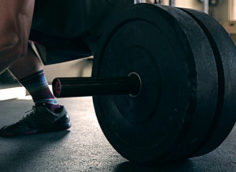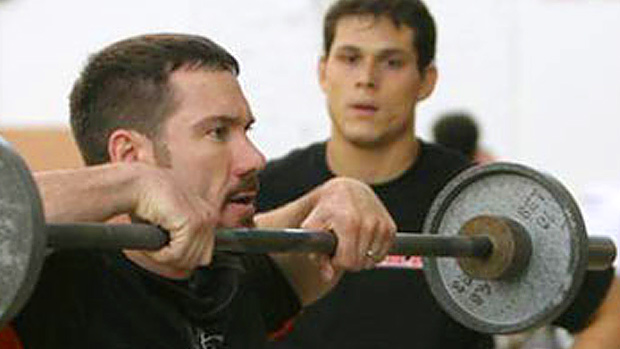In my line of work, I get to see a lot of pitching instructors and hitting coaches. Some have the unbelievable ability to really get through to kids and make them great. On the other hand, there are some that flat-out suck.
As I've seen these two ends of the spectrum, I've come to realize that the best guy to teach you a curveball is rarely the one who has had a dirty 12-to-6 breaking ball since he was in seventh grade. Rather, the guy that can teach you the most is the one who struggled with his curveball for years and tried everything to even turn it into a mediocre pitch.
Likewise, the best hitting coach hasn't batted .400 for a month, let alone a season. The best guy to teach you how to rake is the one who busted his butt to get from a .170 to .250 batting average.
When it comes to deadlifting, I've been pretty blessed. While I've worked my butt off and experimented with a variety of methods to bring it up, it's the lift that's always come naturally to me – to the tune of a 650-pound deadlift at a body weight of 174 pounds in my last competition.
In addition to some good luck and staying healthy, I've also been lucky to have some long arms and a short torso: the ideal deadlifting build. However, this build isn't so ideal when it comes to benching – and that's why I've had to work so hard to get my bench to where it is now.
Honestly, I still don't consider myself a good bencher. I just consider myself a guy who at one time struggled for six months to go from a 225 to 230 bench press 1-rep max – but has managed to make it respectable since then. Here are seven habits of highly defective benchers – many of which I, too, have been guilty of having along the way.
I remember back when we used to lift in high school, and we'd bench 4-5 days a week. At the time, I was about 4'11" with a giant afro (imagine Seth from Superbad) and a whopping 115lb. bench press – but I (like all the guys around me), knew freakin' everything! Why?
Well, because I could just come in and bench and add five pounds every time I came in. It took me from a 45-pound bench press (yes, just the bar) to a grinder at 135 that made chicks want me and guys want to be me. Riiight.
Unfortunately, the road beyond 135 wasn't that simple. While I started to grasp that I couldn't hit a personal best every day, it took me quite a while to realize that even expecting new personal best each week wasn't reasonable. So, along the way, I missed lifts...a LOT of lifts.
In fact, I probably missed that 230 bench press at least 100 times before I got it. And, even then, I have to wonder if I had misloaded the bar or there had been a momentary lapse in gravity.
It wasn't until I stopped missing lifts that my progress really took off. Instead of getting stapled by 235, I hit multiple clean singles at 220 or got sets of 3-5 in at 85% or so. And, the more I succeeded with this mindset, the more I realized that there were times that I walked into the gym where I didn't even plan to come close to failing on a bench press.
Eventually, all these things "clicked," and I found myself writing for two days. The end result was a compilation of all these thoughts and strategies in an e-book, The Art of the Deload, that discusses planned reductions in training stress.
Admittedly, leg drive is something that I am still learning myself. And, among all the big benchers with whom I've spoken, the resounding message is that it doesn't just happen overnight. There is a huge timing component to all of this, and like many other complex tasks in life, it just takes a lot of perfect repetitions to learn.
The one cue I've found works best with everyone I've encountered is that the feet have to be positioned under or behind the knees, but never out in front.


The reasoning is pretty simple; you want to be able to drive your heels into the floor. In the first position, regardless of whether your heel is down or off the ground, you're able to push the heel in this direction. If your feet are out in front, you can't apply force directly down.
This is one that nobody ever told me until after I'd figured it out myself.
Back in the summer of 2003, my shoulder was an absolute disaster; I was in constant pain. This had pretty much been going on for years, ever since I'd been a tennis player in high school and didn't really even know what lifting was. Conventional physical therapy hadn't done squat. The ultrasound they did had raised my IQ by 89 points and made me six inches taller, though.
Kidding aside, the exercises they had me doing might not have been that bad, but they never really gave me any contraindications on what to do in the gym on my own. Of course, things didn't get any better with me overhead pressing and bench pressing.
Anyway, all this didn't work, so, in mid-August of 2003, I was scheduled for surgery for that December, giving me 16 weeks to do whatever I wanted. So, I decided to experiment.
I cut back on my pressing volume, using only decline and flat dumbbell bench presses. And, specific to the topic at hand, I did an obscene amount of horizontal pulling; we're talking over 50 normal sets a week spread out over three sessions, plus lighter theraband work on off-days.
This next two months might have been the most eye-opening of my training career. I gained 8 pounds in my upper back and, more importantly, reduced my symptoms to the point that I called and canceled my surgery on October 30. In other words, I only needed eight weeks to do this – far shorter than a post-surgery rehabilitation program, and a hell of a lot cheaper. That's not all, though.
I continued this training style up through all of December, and early in 2004 I tested my bench for the first time in months. It was up 30 pounds and my deadlift had come along by over 50 pounds in that same time period thanks to some upper back strength.
Since then, I haven't stopped rowing. The bench is up another 90 pounds, the deadlift is up another 200 pounds, and the shoulder's doing well. Now, shouldn't you be doing some rowing?
This one piggybacks on #3, as I later realized that all this upper back work was probably the reason I initially learned how to use a basic bench shirt a little more quickly than most.
You see, with a bench shirt, you have to be cognizant of actually pulling the bar down to you. The shirt can be so tight that the bar won't get down there if you don't pull it, and just as importantly, you want to have the same bar path on each rep, so you have to pull it down to the right spot for consistency.
This pulling has huge implications in terms of shoulder health, too. By activating the muscles of the upper back as if you're doing a row, you're recruiting the muscles that stabilize the scapulae, and that's going to keep your shoulders healthy. A common problem that you'll see in folks who don't sufficiently activate the upper back when benching is that they will slip into anterior scapular tilt in the bottom position. Watch how the front of the shoulder girdle "rolls" forward here:
Incorrect
These folks want to work on stretching out the pec minor and strengthening the lower traps and grooving the "chest up" technique:
Correct
The issue is that you don't ever want to force humeral extension or horizontal abduction on a fixed shoulder blade. By activating the lower traps, you get the shoulder blades tucked down and back, creating a "launching pad" from which you can press with strength and safety.
The year I spent at South Side Gym in Stratford, CT taught me a lot, particularly with respect to benching. Every Friday night, approximately 3,957 insanely large powerlifters crammed into a 1,000-square-foot strength factory to bench for hours on end. Tony Gentilcore and I would drive over an hour to get there, and all along the way, we'd actually be wondering what our first lift was.
I know what you're thinking, Cressey and Gentilcore are supposed to be super-organized planning geeks who've already created periodized plans through 2047!
The truth is that what the main exercise was really didn't matter much until we got closer to competition time and the full-ROM shirted bench took priority. The rest of the time, it was an assortment of full-ROM raw benches, thick bar benches, board presses, reverse band benches, benches against chains, floor presses, and a host of other variations that escape my memory by now.
All that mattered is that we strained a lot with the same general bench stroke. It threw exact specificity out the window, but it worked. We might do a reverse band bench one week, and then not come back to it for nine (or more) weeks. In the middle, we'd kill it on a load of other variations and hit our assistance work. Later, when we came back to the reverse band bench down the road, it'd be up a bit.
Now, compare this to the guy who goes in and just does a regular ol' full-ROM bench press every week. He hammers the same movement pattern over and over again. It works for a while, but stagnates eventually. He never gets the benefits of getting comfortable with heavier weights in his hands from board presses, benches against chains, and reverse band benches. And, he's bored senseless with the monotony.
That said, if you're a beginner, ignore this. You need to get proficient with individual lifts before you worry too much about rotating exercises. Down the road, as you get more advanced, move to rotating to two different main exercises per month, and then on to 3-4 per month.
For some reason, this is one aspect of Louie Simmons' writings that people don't get. The simple way to relate this to people is that if you press fast, you're more likely to press all the way to lockout.
A good analogy would be doing a vertical jump from a seated position. You can spring up quickly and jump pretty high, or you can come up slowly and not even get off the ground. Now, take that same comparison, and do it with a 300-pound weight vest on; you'll still get up in the first example, but might not even leave the chair on the second one.
Most of us were taught that when we first started out with lifting, we should be doing higher reps to learn the movements and strengthen our tissues for the day that we're ready for the heavier stuff. The only problem with this is that you really can't teach bar speed in someone when you're doing sets of 10-12 reps, so people are trained to be slow from the start.
Even if it's just in your warm-ups once a week, take 6-8 sets of three reps at 50-65% of your 1-rep max and focus on accelerating the bar as fast as you can. It'll pay off when you go to test your bench later on.
Earlier, I talked about the importance of a tight upper back so that you can create a stable base from which to press. The shoulder blades have to be retracted with the chest up.
If, however, you try to lift off to yourself, you have to protract the shoulder blades to get the bar over the pins, and that's a sure-fire way to limit how much weight you can use, and put your shoulders in a more vulnerable position. Having someone there to hand off to you enables you to keep your shoulder blades in the right position.
And, for those of you who lift at home who are going to complain that you don't have someone to help, it ensures that you aren't one of the few people who die each year from benching pressing. Use your head (not your neck).
Oh, and for the record, you'll notice that I said "handoffs," and not "spots." "Spot" implies that you're going to need someone to pull the weight off you after you've gotten buried. "Handoff" implies that you just want someone to help you put the bar in the right place so that you can smoke it.
These habits aren't revolutionary, but they've brought me from pathetic and in-pain to a solid mediocre and healthy.





